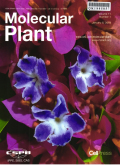- 钛学术文献服务平台 \
- 学术期刊 \
- 基础科学期刊 \
- 生物科学期刊 \
- 分子植物(英文版)期刊 \
Parallel selection of distinct Tof5 alleles drove the adaptation of cultivated and wild soybean to high latitudes
Parallel selection of distinct Tof5 alleles drove the adaptation of cultivated and wild soybean to high latitudes
基本信息来源于合作网站,原文需代理用户跳转至来源网站获取
摘要:
Photoperiod responsiveness is a key factor limiting the geographic distribution of cultivated soybean and its wild ancestor.In particular,the genetic basis of the adaptation in wild soybean remains poorly understood.In this study,by combining whole-genome resequencing and genome-wide association studies we identified a novel locus,Time of Flowering 5(Tof5),which promotes flowering and enhances adaptation to high latitudes in both wild and cultivated soybean.By genomic,genetic and transgenic analyses we showed that Tof5 en-codes a homolog of Arabidopsis thaliana FRUITFULL(FUL).Importantly,further analyses suggested that different alleles of Tof5 have undergone parallel selection.The Tof5H1 allele was strongly selected by humans after the early domestication of cultivated soybean,while Tof5H2 allele was naturally selected in wild soybean,and in each case facilitating adaptation to high latitudes.Moreover,we found that the key flowering repressor E1 suppresses the transcription of Tof5 by binding to its promoter.In turn,Tof5 physically associates with the promoters of two important FLOWERING LOCUS T(FT),FT2a and FT5a,to upregulate their transcription and promote flowering under long photoperiods.Collectively,ourfindings provide insights into how wild soybean adapted to high latitudes through natural selection and indicate that cultivated soybean underwent changes in the same gene but evolved a distinct allele that was artificially selected after domestication.

推荐文章
Thermodynamic properties of San Carlos olivine at high temperature and high pressure
San Carlos olivine
Thermodynamic property
Thermal expansion
Heat capacity
Temperature gradient
High-k材料MOS器件的PISCES-Ⅱ模拟
器件模拟
MOS器件
隧道击穿
high-k
High oxygen fugacity magma: implication for the destruction of the North China Craton
High oxygen fugacity
Decratonization
North China Craton
Plate subduction
内容分析
关键词云
关键词热度
相关文献总数
(/次)
(/年)
引文网络
引文网络
二级参考文献 (0)
共引文献 (0)
参考文献 (0)
节点文献
引证文献 (0)
同被引文献 (0)
二级引证文献 (0)
2022(0)
- 参考文献(0)
- 二级参考文献(0)
- 引证文献(0)
- 二级引证文献(0)
引文网络交叉学科
相关学者/机构
期刊影响力
分子植物(英文版)
主办单位:
中科院上海生命科学研究院植物生理生态所
中国植物生理学会
出版周期:
月刊
ISSN:
1674-2052
CN:
31-2013/Q
开本:
出版地:
上海市岳阳路319号31B楼
邮发代号:
创刊时间:
语种:
eng
出版文献量(篇)
1996
总下载数(次)
1
总被引数(次)
17663
期刊文献
相关文献
推荐文献
- 期刊分类
- 期刊(年)
- 期刊(期)
- 期刊推荐
力学
化学
地球物理学
地质学
基础科学综合
大学学报
天文学
天文学、地球科学
数学
气象学
海洋学
物理学
生物学
生物科学
自然地理学和测绘学
自然科学总论
自然科学理论与方法
资源科学
非线性科学与系统科学
分子植物(英文版)2022
分子植物(英文版)2021
分子植物(英文版)2020
分子植物(英文版)2019
分子植物(英文版)2018
分子植物(英文版)2017
分子植物(英文版)2016
分子植物(英文版)2015
分子植物(英文版)2014
分子植物(英文版)2013
分子植物(英文版)2012
分子植物(英文版)2011
分子植物(英文版)2010
分子植物(英文版)2009
分子植物(英文版)2008

 免费查重
免费查重










